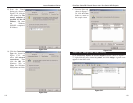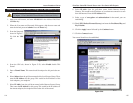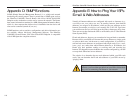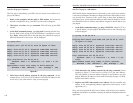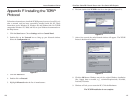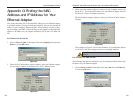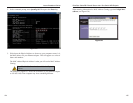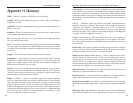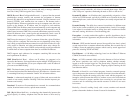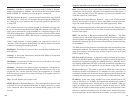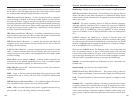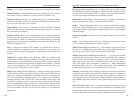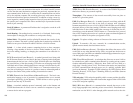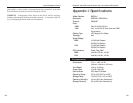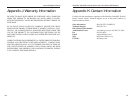
EtherFast
®
Cable/DSL Firewall Router with 4-Port Switch/VPN Endpoint
Multicasting - Sending data to a group of nodes instead of a single destination.
NAT (Network Address Translation) - The translation of an Internet Protocol
address (IP address) used within one network to a different IP address known
within another network. One network is designated the inside network and the
other is the outside.
NetBIOS - The native networking protocol in DOS and Windows networks.
Although originally combined with its transport layer protocol (NetBEUI),
NetBIOS today provides a programming interface for applications at the ses-
sion layer (layer 5). NetBIOS can ride over NetBEUI, its native transport,
which is not routable, or over TCP/IP and IPX/SPX, which are routable proto-
cols.
NetBIOS computers are identified by a unique 15-character name, and
Windows machines (NetBIOS machines) periodically broadcast their names
over the network so that Network Neighborhood can catalog them. For TCP/IP
networks, NetBIOS names are turned into IP addresses via manual configura-
tion in an LMHOSTS file or a WINS server.
There are two NetBIOS modes. The Datagram mode is the fastest mode, but
does not guarantee delivery. It uses a self-contained packet with send and
receive name, usually limited to 512 bytes. If the recipient device is not listen-
ing for messages, the datagram is lost. The Session mode establishes a connec-
tion until broken. It guarantees delivery of messages up to 64KB long.
Network - A system that transmits any combination of voice, video and/or data
between users.
Network Mask - Also known as the "Subnet Mask".
NNTP (Network News Transfer Protocol) - The protocol used to connect to
Usenet groups on the Internet. Usenet newsreaders support the NNTP protocol.
Node - A network junction or connection point, typically a computer or work
station.
Notebook (PC) - A notebook computer is a battery-powered personal comput-
er generally smaller than a briefcase that can easily be transported and conve-
niently used in temporary spaces such as on airplanes, in libraries, temporary
offices, and at meetings. A notebook computer, sometimes called a laptop com-
puter, typically weighs less than five pounds and is three inches or less in thick-
ness.
133
Instant Broadband
®
Series
e-mail address you're sending a note to. At the other end, the recipient can see
the IP address of the Web page requestor or the e-mail sender and can respond
by sending another message using the IP address it received.
IPSec (Internet Protocol Security) - A suite of protocols used to implement
secure exchange of packets at the IP layer. IPSec supports two basic modes:
Transport and Tunnel. Transport encrypts the payload of each packet, leaving
the header untouched, while Tunnel mode encrypts both the header and the pay-
load and is therefore more secure. IPSec must be supported on both transmit-
ter and receiver and must share a public key. Tunnel mode is widely deployed
in VPNs (Virtual Private Networks).
IPX (Internetwork Packet EXchange) - A NetWare communications protocol
used to route messages from one node to another. IPX packets include network
addresses and can be routed from one network to another.
ISP (Internet Service Provider) - A company that provides individuals and
companies access to the Internet and other related services such as Web site
building and virtual hosting.
LAN (Local Area Network) - A group of computers and associated devices that
share a common communications line and typically share the resources of a
single processor or server within a small geographic area (for example, within
an office building).
MAC (Media Access Control) Address - A unique number assigned by the
manufacturer to any Ethernet networking device, such as a network adapter,
that allows the network to identify it at the hardware level.
Mbps (Megabits per second) - One million bits per second; unit of measure-
ment for data transmission.
MD5 - A type of one-way authentication method that uses passwords. MD5
authentication is not as secure as the EAP-TLS or EAP/TTLS authentication
methods.
MIB (Management Information Base) - A set of database objects. This set con-
tains information about a specific device for utilizing SNMP.
mIRC - mIRC runs under Windows and provides a graphical interface for log-
ging onto IRC servers and listing, joining and leaving channels.
132



